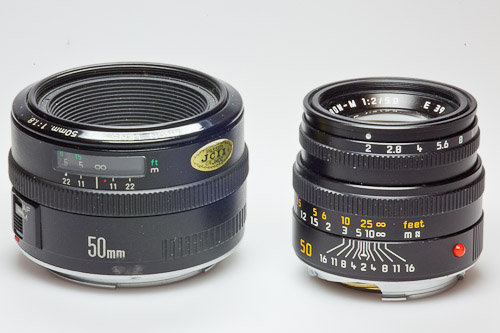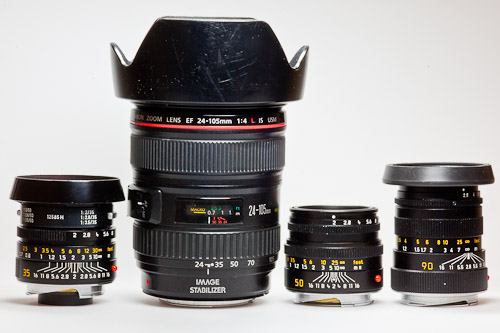How many lenses do you need?
The first lens
If you buy a camera system with interchangeable lenses, you will have to deal with the question of which
lenses to buy first. In former times, a single lens reflex (SLR) camera with a 50 mm lens was part of
the beginner's equipment, thus a standard lens also called standard focal length. The focal length
of such a lens corresponds approximately to the format diagonals, in the case of 35mm (today probably
rather called full format, i.e. 24mm x 36mm sensor size) this is 43mm. A 50mm lens therefore has a
slightly increased focal length. Focal lengths that correspond to the format diagonals have an image
angle that roughly corresponds to natural vision. If you look with one eye through an SLR (SLR camera,
full format) with a normal lens
of 50mm at an object and at the same time with the other eye
directly at the object, you will notice that this lens slightly enlarges the scene (this only applies if
the viewfinder images the scene 1:1, which is rarely the case). The 43mm are almost exactly between 35mm
and 50mm. This will probably also be one reason why the 35mm lens is also very popular and is used by
many photographers as the standard focal length. In the past, not only 50 mm lenses were sold as
standard focal lengths, some suppliers also supplied standard lenses with slightly larger or slightly
smaller focal lengths. Today this has become rather rare, although there is a trend to offer lenses
close to 50mm but not exactly 50mm. As an example the 40mm f/2.8 STM Pancake in the Canon EF system or
the Tamron 45mm f1.8 VC could be mentioned.
As a beginner you didn't really have to worry much. The easiest way was to reach for the 50 (or similar)
or to use a 35mm wide angle lens. The whole thing was a bit complicated (at least from the point of view
of decision making) when zoom lenses were offered. The term zoom is actually misleading, as it refers to
getting closer to an object with a constant focal length while filming. Therefore, lenses with variable
focal lengths were called Vario lenses. However, this did not become generally accepted and today
everyone only talks about zoom lenses; let's stick to this term. A standard zoom in the early years was
a 35-70mm zoom, today it has changed to a 24-70mm or even 24-105mm zoom lens. Such a lens thus offers a
large focal length range in one housing; it seems to be a clear case. Unfortunately, there are also
other differences between a zoom and a fixed focal lengths. The latter often have a better image quality
(let's not focus on this in this article), are much lighter and have a better opening (aperture). Of
course, the point with the weight only applies to moderate
aperture openings of fixed focal
length lenses, i.e. 50mm f1.4 or 35mm f2.0. However, there are also some manufacturers who rely on much
heavier lenses for fabulous imaging performance and consider the weight to be secondary. But let's stick
with a 50 with f1.4 and typical 300g (example Canon EF 50mm f1.4). A comparable zoom has a maximum
aperture of f4.0, i.e. 3 f-stops less (!) and weighs twice as much (e.g. Canon EF 24-70mm f4.0 IS USM),
but a zoom with the same range but a better aperture will quickly triple the weight, i.e. about 900g. A
heavy lens also shifts the centre of gravity of the camera-lens system. You'll soon notice that the
camera is the main weight for a small fixed focal length and that the camera hangs very balanced on the
straps. If you mount a heavy lens, however, the system will tilt forward. This is a lot more
uncomfortable to carry, and of course it is also more difficult to handle because of the increased
weight.
Despite all these points, zooms are very popular and many beginners start their photographer's life with
such a lens. But a zoom increases the complexity of photography. You now have a new camera and you have
to deal with all the features of the new device (and the manufacturers tend to put more and more
functionality in one housing rather than less) and in addition there is the zoom lens. Now you also have
the choice of focal length, besides ISO, aperture, time etc.. But a zoom also has the crucial
disadvantage that it is difficult to train the eye for a certain focal length with such a flexible lens.
If you have practised for a while with a fixed focal length, you will notice that the view is adjusted
to the focal length used and you quickly notice which section you can reach; and that even without
putting the camera against the eye. So you will automatically find an appropriate position to adjust the
frame to the desired one. This getting closer
or getting more distant
really
corresponds to the original concept of zooming (changing the distance to the object at a constant focal
length). The nice thing is that the perspective of the image doesn't shift. If you only rotate the zoom
ring, you will get the frame in one plane, but the perspective will inevitably change, i.e. the frame in
the other planes will change differently than if you approach or move away from the object with a fixed
focal length.

Lens preferences in the course of time
I also started to photograph over 30 years ago with a zoom. The desire for an even larger focal length
range soon arose. The next step beside a standard zoom (e.g. 35-70mm) was a tele zoom (e.g. 75-300mm).
Wide-angle zooms weren't that popular back then, so the next thing that followed was an extreme
wide-angle lens (17mm) and a fish eye lens (15mm). Over time, these lenses were replaced by more
powerful ones (i.e. 28-70 f2.8 and 70-200f 2.8) and then by higher quality ones (in the Canon system
these are the parts with the red ring, i.e. L
lenses). With the purchase of a Contax G2, a
Hasselblad XPAN and later a Leica M8, however, fixed focal lengths were increasingly used again, simply
because they were not or hardly available for rangefinder cameras. And so I quickly learned how
comfortable such a small, handy lens is. Especially when you place a Canon AF zoom next to a Leica fixed
focal length, you're amazed. And also the comparison of two fixed focal lengths from the two systems is
very impressive. The same of course applies to lenses from any other camera manufacturer or third-party
lens manufacturer. After this experience, I also decided on fixed focal lengths for the Canon system.
First I started with three lenses: a 35mm f2.0, a 50mm f1.4 and a macro 100mm f2.8. This reduced
equipment allowed me to use a small, handy photo bag. After a while I noticed that the 50mm lens was
attached to the camera 90% of the time and finally I left the bag with the other two lenses at home more
and more often. For about 2 years now I have been photographing almost always with only one focal length
and I find this experience very positive. From time to time I switch to a 35 lens instead of a 50 lens.
But the 50 is still the most used lens in my collection. Of course a 400mm lens is still used for animal
photography and a 14mm or a fish eye lens for polar lights, but in photographic everyday
life
the 50 is my standard focal length. And the great thing about it is that you don't have to
worry about photo bags anymore.
